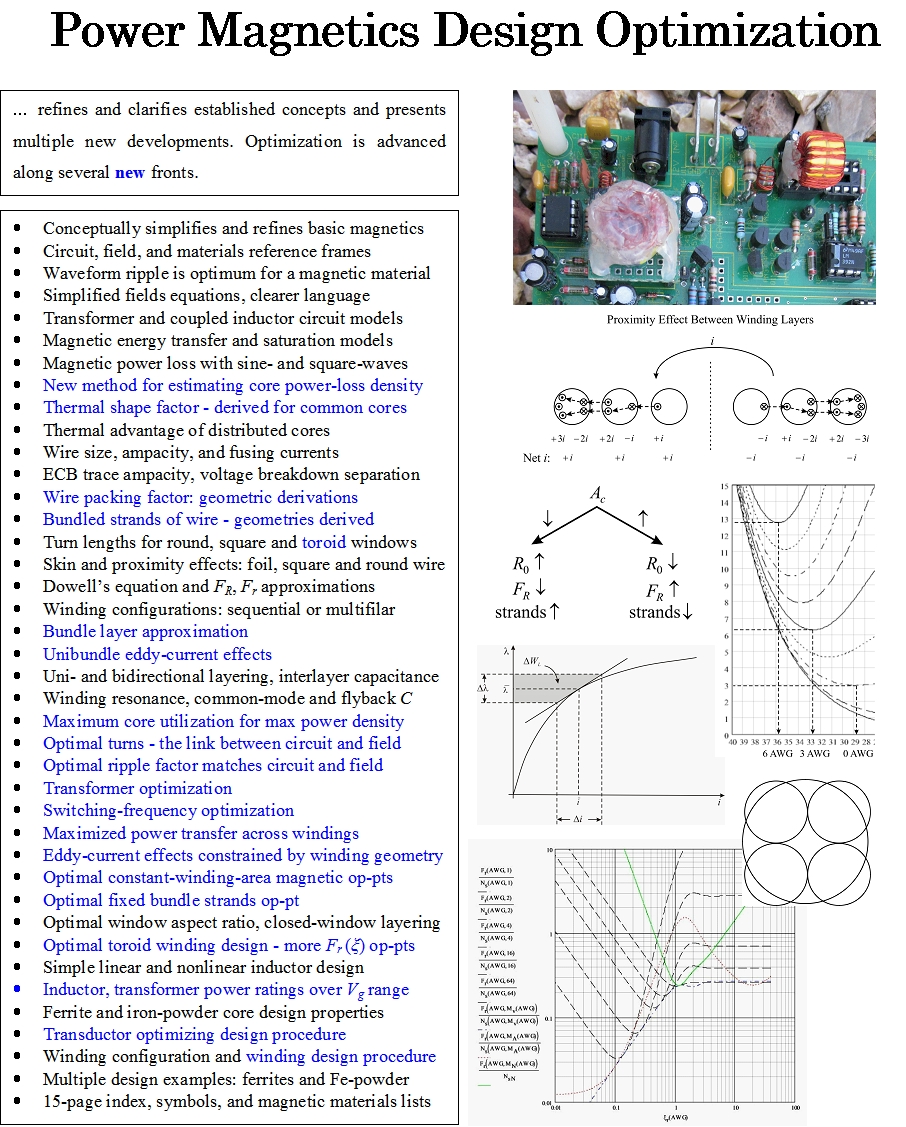

Preface
Structure, Behavior, and Function 1
Waveform Parameters 1
Average and RMS Power 4
Sinusoidal Power 8
Waveform Phasing 9
Current Waveforms 11
Average and RMS Values of Added Waveforms 15
Waveform Performance Parameters 17
Ripple Characterization 19
Quantities of Electricity and Magnetism 22
Maxwell’s Equations 23
Faraday’s Law 23
Ampere’s Law 25
Gauss’s Electric Law 25
Gauss’s Magnetic Law 26
Magnetic Reference Frames 27
Magnetic-Electric Analogs 29
Magnetic Ohm’s Law 29
Magnetic Kirchhoff’s Laws 29
Inductance From Geometry 31
Solenoid Inductance 31
Toroid Inductance 32
Terminology 34
AC and DC 34
Electric and Magnetic Quantity Names 35
Mutual Inductance 37
Transductor Circuit Models 41
Transductor Model from Measurements 44
Isolated Transductor Circuit Model 45
Transductor Circuit Transforms 46
Three-Terminal Configurations 50
Magnetic Energy 52
Energy Transfer and Ripple 55
Magnetic Saturation 57
Magnetic Saturation Approximation 63
Magnetic Power Loss 65
Square-Wave Magnetic Power Loss 69
Magnetic Core Materials 71
Magnetic Energy Density of Cores 74
Core Power-Loss Density Estimation 75
Thermal Shape Factor 80
Rectangular Toroid Power-Loss Density 82
Round Toroid Power-Loss Density 84
EE Core Power-Loss Density 85
ETD Core Power-Loss Density 86
Pot Core Power-Loss Density 87
Core-Shape Thermal Performance 89
Thermal Advantage of Distributed Cores 90
Wire Size 92
Conductor Ampacity 94
Wire Fusing Current 95
Etched Circuit Board Traces 98
Wire Packing Factor 99
Wire Packing Factor - Mathcad Listing 106
Innovatia Wire Table 108
Bundled Strands of Wire 109
Winding Turn Length: Round Window 120
Winding Turn Length: Square Window 121
Winding Area: Round Window 123
Winding Area: Square Window 126
Toroid Turn Length 127
Example 132
Toroid Window Fill Factor 132
Wound Toroid Volume 133
Skin Effect 135
Frequency-Dependent Resistance 142
Proximity Effect 143
Equivalent Foil, Square and Round Wire 145
Dowell’s Equation 150
Fr and Minimum Winding Resistance 153
FR Approximation 161
Approximate Minimum Rw for Foil 162
Approximate Minimum Rw for Wire 163
Winding Design Example 165
Winding Loss from Waveshape 166
Foil, ECB Traces, and Winding Shape 170
Aluminum or Copper Wire 171
Winding Sequence 174
Leakage Inductance Reduction 175
Leakage Inductance in Winding Window 176
Leakage Inductance FL Effects 177
Single-Bundle Multifilar Windings 178
Bundle Layer Approximation 184
Unibundle Eddy-Current Effects 186
Layering and Interlayer Capacitance 191
Distributed Capacitance and Voltage 192
Charge on Distributed Capacitance 193
Interlayer Voltage from Field Energy 196
Unidirectional Winding Technique 198
Concentric Winding Sequencing 198
Capacitance of Two Loops 200
Bifilar
Capacitance of Adjacent Layers 204
Toroid Concentric Winding Capacitance 207
Winding Resonance 210
Common-Mode Transformer Capacitance 211
Forward Converter Interwinding Capacitance 213
Flyback & IsoCuk Interwinding Capacitance 214
Flyback Switching & Interwinding Capacitance 216
Maximum Core Utilization 220
Optimal Turns 221
Winding Window Turns Limitation 225
Optimal Ripple Factor 226
Resistance-Matching Circuit and Field 229
Optimal Turns from Nλ and Ni 233
Core Volume Minimization 234
Transfer Power for Multiple Windings 236
Maximized Transfer and Utilization 238
Transductor Design Optimization 240
Air Gap Optimization of Magnetic Path 243
Optimal Ferrite Core Operating-Point 245
Maximum Power with Large Ripple 247
Transformer Optimization 251
Frequency Optimization 255
Optimal Core Geometry 260
Area-Product Core Selection 264
One-Sided Power-Loss Circuit Models 265
Maximum Output Power 269
Maximum Power Transfer 270
Circuit Equations for Pc = Pw 273
Secondary Maximum η(Is) and η(Vs) 275
Secondary Max-η(Vp’) with Voltage-Source Load 279
Secondary Max-η(Vs) with Current-Source Load 281
Primary Max-η(Vs’) with Voltage-Source Load 283
Primary Max-η(Vp) with Voltage-Source Load 285
Primary Max-η(Vs’) with Current-Source Load 286
Generalized η and ψ Equations 288
General Power-Transfer Circuit Model 289
Efficiency 291
Core and Winding Power Loss 292
Power-Loss Ratio 295
Optimal Voltage and Power-Loss Ratios 297
βmax and Optimal Rw 300
Minimum-Power-Loss Optimization 302
Minimum Power Loss with Voltage- and Current-Source Loads 304
Minimum-Loss Turns 307
Winding Optimization 308
Winding Geometry 309
Optimal Strands Under Static Condition 311
Eddy-Current Effects and Winding Geometry 313
Minimum-Fr Mv(rcw) 315
Constant-Area MA(rcw) 317
Constant-Strands MN(rcw) 318
Winding Design Constraints Compared 319
Dowell's Equation - Design Optimization - Mathcad Listing 323
Optimal Window Aspect Ratio 335
Linear Layering in a Closed Winding Window 336
Toroid Winding Design 337
Simple Linear Inductor Design 352
Simple Nonlinear Inductor Design 353
Example Inductor Design 355
Transductor Board Assembly 356
Design Power for a Vg Range 357
Power Flows 358
Inductor Power 360
Inductor Design Power 363
Transformer Waveforms and Power 368
Primary Winding and Input Power 369
Transformer Design Power 369
Core Sizing 374
Ferrite Designs 375
Iron-Powder Designs 377
Transductor Design Procedure 379
Transductor Specification 379
Core Material, Frequency, and Size 380
Magnetic Operating-Point 381
Optimal Ripple Factor, Nw, and L Range 381
Optimal Turns, Inductance, and Power 383
Core Power Loss 384
Winding Configuration 385
Winding Design Procedure 387
Design Example: Ćuk Transductor 390
Specifications 390
Ćuk Converter Transductor Behavior 392
EE Core: EE2425 or E25/10/6 3C90 393
Magnetic Design 393
Electric Design 396
Planar E Core: E18/4/10/R 3F3 401
Magnetic Design 401
Electric Design 404
Toroids: Fe-Powder 2 T80B 20 mm 410
Magnetic Design 411
Electric Design 413
FeSiAl Design: 7705x 12.7 mm Toroid 416
NiFeMo Design: 550xx 12.7 mm Toroid 417
NiFe Design: 12.7 mm Toroid 419
FeSi Design: E12.7/6.4/3.6 420
Design Example: Buck Inductor 422
Design
Example:
Transformer Design 427
Inductor Design 435
Closure 439
A - W 440
Symbols 451
Materials 455
Tables and Mathcad Programs 455
456 numbered pages
465 total nonblank pages
466 total pages
![]()